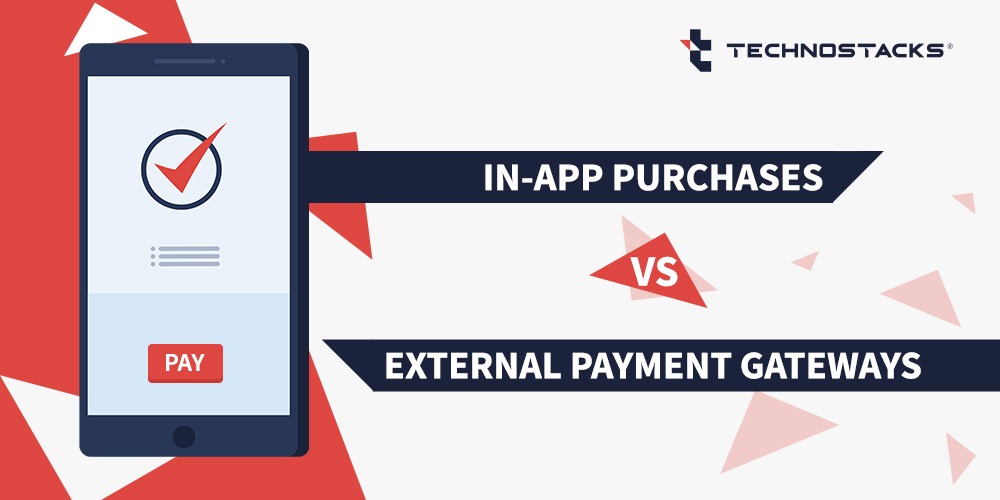What to choose between in-app purchases and external payment gateway?
Today, it is an indisputable fact that almost everything across the globe has gone mobile. More individuals than ever are utilizing apps across an extensive range of ages or professions. While when we talk about applications, people use professional, sports, entertainment, or learning apps extensively in their day-to-day lives.
All types of businesses are switching to mobile strategies to reach out to a broader customer base; however, this is not as straightforward or easy as you think. There are plentiful considerations, and a big one for any profit-making business that sells consumer products is how precisely to collect payments.
Exploring your Payment Preferences
When downloading an application, you would have experienced that even free apps can comprise in-app purchases. While utilizing an app, you would prefer to purchase access to added functionalities, content or go for a paid subscription.
One of the best examples is a gaming application that provides free access to download for the app. However, once users initiate playing, they can pay for stuff such as added power, additional clothing, or exceptional capabilities for their character that improves the game play.
This payment model helps many developers and game-based companies make business profits while still providing the app’s basic version for free to draw more users.
Many companies, like Google and Apple, provide in-app purchasing platforms. However, there are also external payment gateways accessible by 3rd party service providers like PayPal, Stripe, or Clover that you will need to consider. Relying on your category of application, which methodology to utilize may or may not be an obvious selection.
How In-App Purchases Run?
The in-app purchase methodology is needed at times for mobile applications in the App Store and Google Play. The in-app purchase is built-in functionality for development professionals to control. It is relatively trouble-free to implement and connect safely to the associated device with a precise user account on the other side.
While it is a flawless user experience, the fee linked is probably not so refreshing, as both Google and Apple take hefty cuts. The development professionals can access the needed tools to develop in-app purchases.
However, in-app purchase gateways are not a prerequisite in all cases, and there are reasons to consider utilizing an external payment gateway.
Diverse Use Cases of In-App Purchases
When you sell anything that is linked to the functionality the application executes directly or that exclusively exists within the application, you have to utilize In-App Purchases.
For instance, if your mobile app is a game and users can purchase currency to use right in the game through the application, you should apply In-App Purchases.
Suppose you have a video editing application, and users can access a narrow free version. However, they can pay for more functionality or a premium version within the application. In that case, you will require utilizing In-App Purchases.
The Pros of In-App Purchases
It offers app development professionals more options to enable marketing tactics and more approaches to make sales and create revenue streams.
It facilitates you to make special deals to the precise users at the correct time, particularly with all the updates Apple and Google have made regarding subscriptions. When done accurately, this can have massive reimbursement for a business.
The Cons of In-App Purchases
The back-end development of In-App Purchases demands a lot more effort and time from expert developers. It is much more complex in terms of coding, and often needs continuous technical support. Developers necessitate being dynamic and in touch with their users to keep them satisfied.
Exploring External Payment Gateways
By using stringent security protocols and encryption, an external payment gateway enables transaction data securely from your application to diverse payment processors, including banks and other financial institutions.
This is a significant benefit for development professionals and your company brand, as it prevents your application from having a data breach. The process to facilitate an external payment gateway is even less labor demanding for development professionals.
However, enabling 3rd party software within your application will always lead to an exterior element of your control. However, it is tough to deny the essential benefits of using external payment gateways and mobile app payment gateway integration when it comes to direct costs and time.
By and large, there are multiple approaches to enable external payment gateways:
-
Hosted Payment Gateway
Works as a 3rd party solution, needing application users to leave and access a different digital platform to facilitate a transaction. These can work well for small and local business set-ups.
The Pros:
No monetary data is stored on your application, needing no PCI compliance, and is simple to integrate.
The Cons:
You don’t manage a hosted gateway, and some users may not have a reliance on 3rd party payment systems. Also, redirecting users away from your application reduces conversion rates and isn’t profitable for your brand. -
Direct Post
It is an integration methodology enabling users to shop without departing your application; however, you don’t have to get PCI compliance. It assumes the transaction’s information will be posted to a 3rd party payment gateway when a user clicks the buying button. The information right away travels to the external payment gateway and processor without storing it on the server.
The Pros:
You get the tailored preferences and branding abilities without enabling PCI DSS compliance. The user allows for all the needed actions on one single page, making it a right fit for companies of all types and sizes.
The Cons:
You can’t assure that it is entirely safe and secure, as it is not under your comprehensive authority. -
Non-Hosted Payment Methodology
It is integrated through external APIs to your server. As a result, it will need an IT solutions company to execute the integration. Most service providers have entirely documented integration guides and references of API’s. This scenario is a practical choice for medium and large business companies that depend on user experience and branding.
The Pros:
You have complete control over the transactions on your application. You can tailor your payment system as you want and personalize it to your business demands.
The Cons:
Sustaining the infrastructure and turning PCI compliant to store users’ payment-related details on your own servers. Blending the gateway can be complicated and timely if you want to add personalized functions.
In-App Purchases vs. External Payment Gateways
How to choose a good payment gateway? In the end, this comes down to what your application is, how it works, and what your business delivers. If your application is a “freemium” app providing mobile products that work within your app’s perspective, you should opt for In-App Purchases.
If you are dealing with or selling physical products or services through the app, you must process payments through an external payment gateway.
Key Takeaways
So, what is the best payment method? Understanding when you require utilizing in-app purchases is significant. While it’s fitting and secure, it does have its negative aspects. On the other hand, external payment gateways are advantageous when it comes to development costs and required time. However, they lead to low conversion rates. So, both have their own benefits and limitations.
Technostacks is a leading IT services agency and if you have any challenges related to the payment gateway or app developments, then connect with us. We are here to assist you.









